Woods Equipment DS120, DS96 User Manual
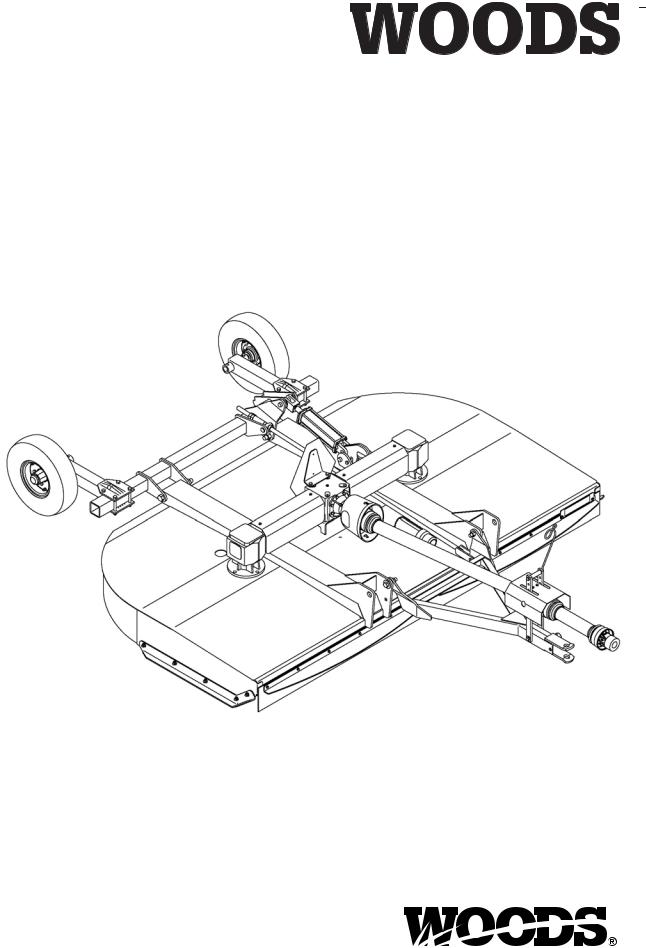
ROTARY CUTTER
DS96
DS120
MAN0390 (Rev. 5/5/2011)

 OPERATOR'S MANUAL
OPERATOR'S MANUAL
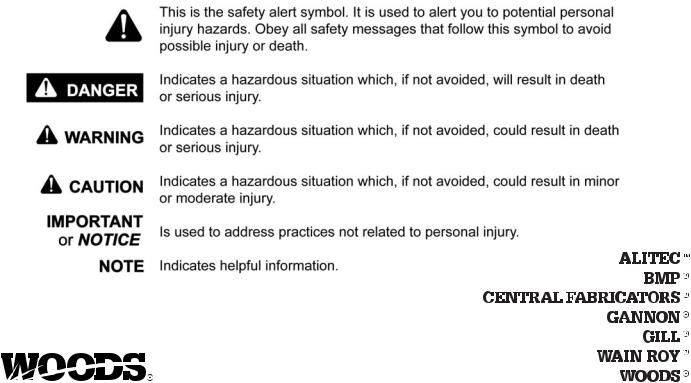
TO THE DEALER:
Assembly and proper installation of this product is the responsibility of the Woods® dealer. Read manual instructions and safety rules. Make sure all items on the Dealer’s Pre-Delivery and Delivery Check Lists in the Operator’s Manual are completed before releasing equipment to the owner.
The dealer must complete the online Product Registration form at the Woods Dealer Website which certifies that all Dealer Check List items have been completed. Please contact your dealer to complete this form. Dealers can register all Woods product at dealer.WoodsEquipment.com under Product Registration.
Failure to register the product does not diminish customer’s warranty rights.
TO THE OWNER:
Read this manual before operating your Woods equipment. The information presented will prepare you to do a better and safer job. Keep this manual handy for ready reference. Require all operators to read this manual carefully and become acquainted with all adjustment and operating procedures before attempting to operate. Replacement manuals can be obtained from your dealer. To locate your nearest dealer, check the Dealer Locator at www.WoodsEquipment.com, or in the United States and Canada call 1-800-319-6637.
The equipment you have purchased has been carefully engineered and manufactured to provide dependable and satisfactory use. Like all mechanical products, it will require cleaning and upkeep. Lubricate the unit as specified. Observe all safety information in this manual and safety decals on the equipment.
For service, your authorized Woods dealer has trained mechanics, genuine Woods service parts, and the necessary tools and equipment to handle all your needs.
Use only genuine Woods service parts. Substitute parts will void the warranty and may not meet standards required for safe and satisfactory operation. Record the model number and serial number of your equipment in the spaces provided:
Model: _______________________________ |
Date of Purchase: _____________________ |
Serial Number: (see Safety Decal section for location) ____________________________________
Provide this information to your dealer to obtain correct repair parts.
Throughout this manual, the term NOTICE is used to indicate that failure to observe can cause damage to equipment. The terms CAUTION, WARNING, and DANGER are used in conjunction with the Safety-Alert Symbol (a triangle with an exclamation mark) to indicate the degree of hazard for items of personal safety.
|
|
|
|
2 Introduction |
Gen’l (Rev. 3/5/2010) |
||
|
|
|
|
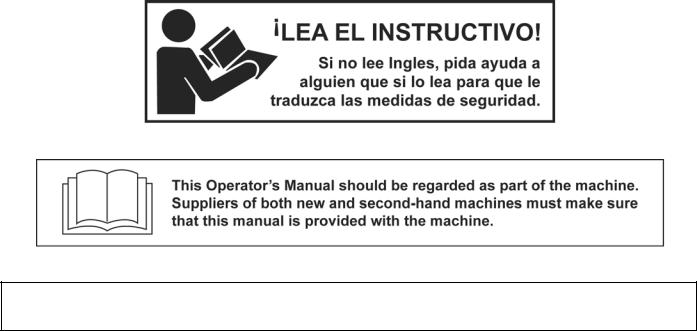
TABLE OF CONTENTS
INTRODUCTION . . . . . . . . . . . . . . . . . . . . . . . . . . . . . . . . . . . . . . . . . . . . . . 2 SPECIFICATIONS . . . . . . . . . . . . . . . . . . . . . . . . . . . . . . . . . . . . . . . . . . . . . 4 GENERAL INFORMATION . . . . . . . . . . . . . . . . . . . . . . . . . . . . . . . . . . . . . . 4 SAFETY VIDEO ORDER FORM . . . . . . . . . . . . . . . . . . . . . . . . . . . . . . . . . . 5 SAFETY RULES . . . . . . . . . . . . . . . . . . . . . . . . . . . . . . . . . . . . . . . . . . . . . . 7 SAFETY DECALS . . . . . . . . . . . . . . . . . . . . . . . . . . . . . . . . . . . . . . . . . . . . .11 OPERATION . . . . . . . . . . . . . . . . . . . . . . . . . . . . . . . . . . . . . . . . . . . . . . . . 14 OWNER SERVICE . . . . . . . . . . . . . . . . . . . . . . . . . . . . . . . . . . . . . . . . . . . 21 TROUBLESHOOTING . . . . . . . . . . . . . . . . . . . . . . . . . . . . . . . . . . . . . . . . 26 DEALER SERVICE . . . . . . . . . . . . . . . . . . . . . . . . . . . . . . . . . . . . . . . . . . . 27 ASSEMBLY INSTRUCTIONS . . . . . . . . . . . . . . . . . . . . . . . . . . . . . . . . . . . 37 DEALER CHECK LIST . . . . . . . . . . . . . . . . . . . . . . . . . . . . . . . . . . . . . . . . 49 INDEX TO PARTS LISTS . . . . . . . . . . . . . . . . . . . . . . . . . . . . . . . . . . . . . . 51 BOLT TORQUE CHART . . . . . . . . . . . . . . . . . . . . . . . . . . . . . . . . . . . . . . . 73 BOLT SIZE CHART & ABBREVIATIONS . . . . . . . . . . . . . . . . . . . . . . . . . . 74 INDEX . . . . . . . . . . . . . . . . . . . . . . . . . . . . . . . . . . . . . . . . . . . . . . . . . . . . . 75 PRODUCT WARRANTY . . . . . . . . . . . . . . . . . . . . . . . INSIDE BACK COVER REPLACEMENT PARTS WARRANTY . . . . . . . . . . . . . . . . . . .BACK COVER
(Rev. 4/6/2007)
MAN0390 (Rev. 6/30/2006)
Introduction 3
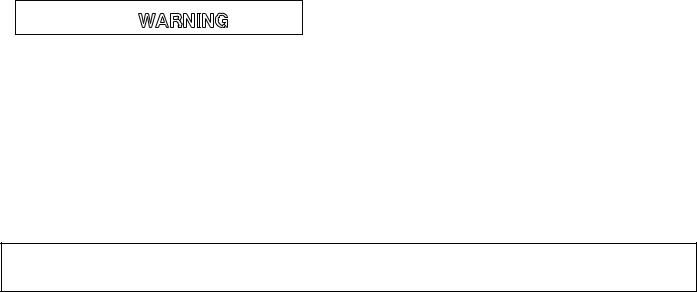
SPECIFICATIONS
|
DS96 |
DS120 |
Cutting Height (varies with tire selection) |
2" - 15" |
2" - 15" |
Cutting Width |
96" |
120" |
Overall Width |
103" |
127" |
Tractor HP |
40 - 120 |
40 - 120 |
Tractor PTO rpm |
540 |
540 |
Blade Spindle |
2 |
2 |
Blade Overlap |
4" |
4" |
Number of Blades |
4 |
4 |
Center Driveline with Slip Clutch |
Cat 4 |
Cat 4 |
Side Frame Thickness |
7 ga |
7 ga |
Weight - Pull-Type (approximate lbs.) |
1,800 |
1,930 |
Blade Speed (feet per minute) |
15,900 |
16,700 |
Blade Rotation |
Left Spindle: CCW; Right Spindle: CW |
|
Wheel Size |
15" Rims or 21" OD Solid Tires |
|
|
22" or 29" Used Aircraft Tires |
|
Torsion Protection |
Slip Clutch and Flex Couplers |
|
|
|
|
GENERAL INFORMATION

Some illustrations in this manual show the equipment with safety shields removed to provide a better view. This equipment should never be operated with any necessary safety shielding removed.
The purpose of this manual is to assist you in operating and maintaining your cutter. Read it carefully. It furnishes information and instructions that will help you achieve years of dependable performance. These instructions have been compiled from extensive field experience and engineering data. Some information
may be general in nature due to unknown and varying operating conditions. However, through experience and these instructions, you should be able to develop procedures suitable to your particular situation.
The illustrations and data used in this manual were current at the time of printing but, due to possible inline production changes, your machine may vary slightly in detail. We reserve the right to redesign and change the machines as may be necessary without notification.
Throughout this manual, references are made to right and left directions. These are determined by standing behind the equipment facing the direction of forward travel. Blade rotation is clockwise (right) and counterclockwise (left) as viewed from the top of the cutter.
4 Introduction |
MAN0390 (Rev. 6/30/2006) |
|

Safety Video Order Form
BE SAFE!
BE ALERT!
BE ALIVE!
BE TRAINED
Before Operating Mowers!
Safety Training
Does Make a Difference.
ASSOCIATION OF
EQUIPMENT
MANUFACTURERS
Free Mower Safety Video
Fill out and return the order form and we will send you a FREE VHS or DVD video outlining Industrial and Agricultural Mower Safety Practices. The 22 minute video, developed in cooperation with AEM (Association of Equipment Manufacturers), reinforces the proper procedures to follow while operating your mowing equipment. The video does not replace the information contained in the Operator’s Manual, so please review this manual thoroughly before operating your new mowing equipment.
Safety Video Order Form (8/2/2005)
Safety 5

Also, available from the Association of Equipment Manufacturers:
A large variety of training materials (ideal for groups) are available for a nominal charge from AEM. Following is a partial list:
●Training Package for Rotary Mowers/Cutters-English
Contains: DVD & VHS (English)
Guidebook for Rotary Mowers/Cutters (English)
AEM Industrial/Agricultural Mower Safety Manual (English) AEM Agricultural Tractor Safety Manual (English)
●Training Package for Rotary Mowers/Cutters-English/Spanish
Contains: DVD & VHS (English/Spanish)
Guidebook for Rotary Mowers/Cutters (English/Spanish)
AEM Industrial/Agricultural Mower Safety Manual (English/Spanish) AEM Agricultural Tractor Safety Manual (English/Spanish)
AEM training packages are available through:
AEM at: www.aem.org or
Universal Lithographers, Inc. Email: aem@ulilitho.com 800-369-2310 tel 866-541-1668 fax
Free Mower/Cutter Safety Video Order Form
3 (Select one)
VHS Format - VHS01052 Safety Video
Please send me
DVD Format - DVD01052 Safety Video
Name: ________________________________________ Phone: __________________
Address: _____________________________________
_____________________________________
_____________________________________
Mower/Cutter Model: ______________________ Serial #: ________________________
Send to: ATTENTION: DEALER SERVICES
WOODS EQUIPMENT COMPANY
PO BOX 1000
OREGON IL 61061-1000
USA
6 Safety
Safety Video Order Form (Rev. 2/6/2006)
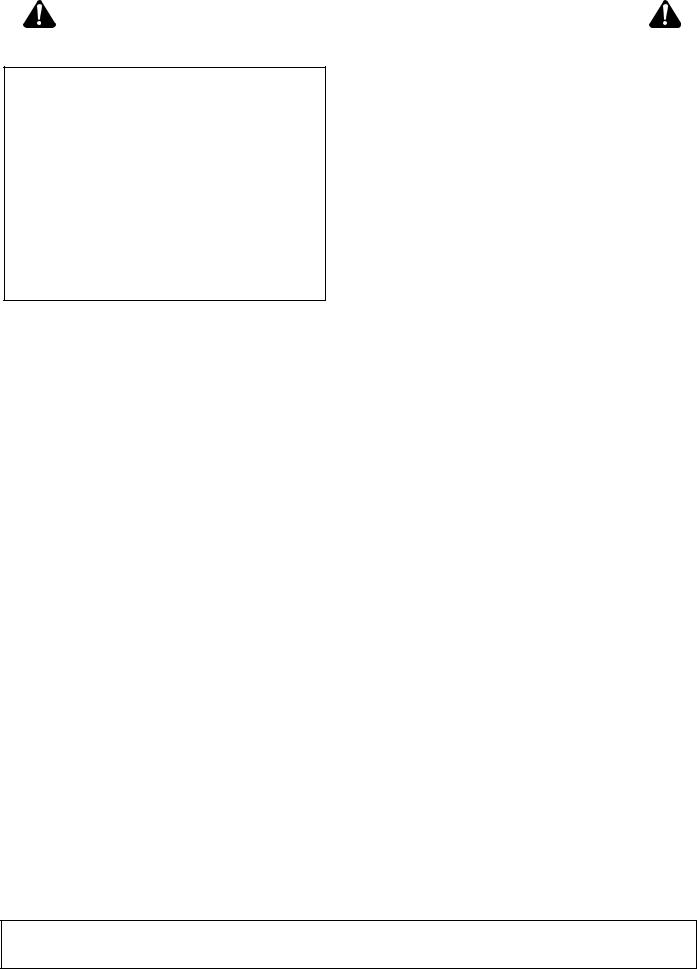
SAFETY RULES
ATTENTION! BECOME ALERT! YOUR SAFETY IS INVOLVED!
Safety is a primary concern in the design and manufacture of our products. Unfortunately, our efforts to provide safe equipment can be wiped out by an operator’s single careless act.
In addition to the design and configuration of equipment, hazard control and accident prevention are dependent upon the awareness, concern, judgement, and proper training of personnel involved in the operation, transport, maintenance, and storage of equipment.
It has been said, “The best safety device is an informed, careful operator.” We ask you to be that kind of operator.
TRAINING
Safety instructions are important! Read all attachment and power unit manuals; follow all safety rules and safety decal information. (Replacement manuals and safety decals are available from your dealer. To locate your nearest dealer, check the Dealer Locator at www.WoodsEquipment.com, or in the United States and Canada call 1-800-319- 6637.) Failure to follow instructions or safety rules can result in serious injury or death.
If you do not understand any part of this manual and need assistance, see your dealer.
Know your controls and how to stop engine and attachment quickly in an emergency.
Operators must be instructed in and be capable of the safe operation of the equipment, its attachments, and all controls. Do not allow anyone to operate this equipment without proper instructions.
Keep hands and body away from pressurized lines. Use paper or cardboard, not hands or other body parts to check for leaks. Wear safety goggles. Hydraulic fluid under pressure can easily penetrate skin and will cause serious injury or death.
Make sure that all operating and service personnel know that if hydraulic fluid penetrates skin, it must be surgically removed as soon as possible by a doctor familiar with this form of injury or gangrene, serious injury, or death will result. CONTACT A PHYSICIAN IMMEDIATELY IF FLUID ENTERS SKIN OR EYES. DO NOT DELAY.
Never allow children or untrained persons to operate equipment.
PREPARATION
Check that all hardware is properly installed. Always tighten to torque chart specifications unless instructed otherwise in this manual.
Air in hydraulic systems can cause erratic operation and allows loads or equipment components to drop unexpectedly. When connecting equipment or hoses or performing any hydraulic maintenance, purge any air in hydraulic system by operating all hydraulic functions several times. Do this before putting into service or allowing anyone to approach the equipment.
Make sure all hydraulic hoses, fittings, and valves are in good condition and not leaking before starting power unit or using equipment. Check and route hoses carefully to prevent damage. Hoses must not be twisted, bent sharply, kinked, frayed, pinched, or come into contact with any moving parts. Operate moveable components through full operational range to check clearances. Replace any damaged hoses immediately.
Always wear relatively tight and belted clothing to avoid getting caught in moving parts. Wear sturdy, rough-soled work shoes and protective equipment for eyes, hair, hands, hearing, and head; and respirator or filter mask where appropriate.
Make sure attachment is properly secured, adjusted, and in good operating condition.
Make sure spring-activated locking pin or collar slides freely and is seated firmly in tractor PTO spline groove.
If equipped with driveline guard tether chains, make sure they are attached to the tractor and equipment as shown in the pamphlet that accompanies the driveline. Replace if damaged or broken. Check that driveline guards rotate freely on driveline before putting equipment into service.
Power unit must be equipped with ROPS or ROPS cab and seat belt. Keep seat belt securely fastened. Falling off power unit can result in death from being run over or crushed. Keep foldable ROPS system in “locked up” position at all times.
Inspect chain shielding before each use. Replace if damaged.
(Safety Rules continued on next page)
DS96-DS120 Safety Rules (Rev. 5/11/2007)
Safety 7

SAFETY RULES
ATTENTION! BECOME ALERT! YOUR SAFETY IS INVOLVED!
(Safety Rules continued from previous page)
Remove accumulated debris from this equipment, power unit, and engine to avoid fire hazard.
Make sure all safety decals are installed. Replace if damaged. (See Safety Decals section for location.)
Make sure shields and guards are properly installed and in good condition. Replace if damaged.
Do not put this equipment into service unless all side skids are properly installed and in good condition. Replace if damaged.
A minimum 20% of tractor and equipment weight must be on the tractor front wheels when attachments are in transport position. Without this weight, front tractor wheels could raise up resulting in loss of steering. The weight may be attained with front wheel weights, ballast in tires or front tractor weights. Weigh the tractor and equipment. Do not estimate.
Inspect and clear area of stones, branches, or other hard objects that might be thrown, causing injury or damage.
OPERATION
Full chain or rubber shielding must be installed when operating in populated areas or other areas where thrown objects could injure people or damage property.
•If this machine is not equipped with full chain or rubber shielding, operation must be stopped when anyone comes within 300 feet (92 m).
•This shielding is designed to reduce the risk of thrown objects. The mower deck and protective devices cannot prevent all objects from escaping the blade enclosure in every mowing condition. It is possible for objects to ricochet and escape, traveling as much as 300 feet (92 m).
Do not allow bystanders in the area when operating, attaching, removing, assembling, or servicing equipment.
Never direct discharge toward people, animals, or property.
Do not operate or transport equipment while under the influence of alcohol or drugs.
Operate only in daylight or good artificial light.
Keep hands, feet, hair, and clothing away from equipment while engine is running. Stay clear of all moving parts.
Always comply with all state and local lighting and marking requirements.
Never allow riders on power unit or attachment.
Power unit must be equipped with ROPS or ROPS cab and seat belt. Keep seat belt securely fastened. Falling off power unit can result in death from being run over or crushed. Keep foldable ROPS system in “locked up” position at all times.
Always sit in power unit seat when operating controls or starting engine. Securely fasten seat belt, place transmission in neutral, engage brake, and ensure all other controls are disengaged before starting power unit engine.
Operate tractor PTO at 540 RPM. Do not exceed.
Look down and to the rear and make sure area is clear before operating in reverse.
Do not operate or transport on steep slopes.
Do not stop, start, or change directions suddenly on slopes.
Use extreme care and reduce ground speed on slopes and rough terrain.
Watch for hidden hazards on the terrain during operation.
Stop power unit and equipment immediately upon striking an obstruction. Turn off engine, remove key, inspect, and repair any damage before resuming operation.
Leak down or failure of mechanical or hydraulic system can cause equipment to drop.
On pull-type or semi-mounted units with optional hydraulic cutting height adjustment, use a single-acting cylinder with a maximum extended length of 28-1/4" (718 mm) from attaching point center to center.
On mounted units with optional hydraulic cutting height adjustment, use a double-acting cylinder with a maximum extended length of 28-1/4" (718 mm) from attaching point center to center.
TRANSPORTATION
The maximum transport speed for towed and semi-mounted machines is 20 mph (32 km/h). Regardless of the maximum speed capability of the towing tractor, do not exceed the implement’s max-
8 Safety
DS96-DS120 Safety Rules (Rev. 5/11/2007)

SAFETY RULES
ATTENTION! BECOME ALERT! YOUR SAFETY IS INVOLVED!
imum transport speed. Doing so could result in:
•Loss of control of the implement and tractor
•Reduced or no ability to stop during braking
•Implement tire failure
•Damage to the implement or its components.
Use additional caution and reduce speed when under adverse surface conditions, turning, or on inclines.
Do not operate PTO during transport.
Never tow this implement with a motor vehicle.
Do not operate or transport on steep slopes.
Do not operate or transport equipment while under the influence of alcohol or drugs.
Always comply with all state and local lighting and marking requirements.
Never allow riders on power unit or attachment.
MAINTENANCE
Before dismounting power unit or performing any service or maintenance, follow these steps: disengage power to equipment, lower the 3-point hitch and all raised components to the ground, operate valve levers to release any hydraulic pressure, set parking brake, stop engine, remove key, and unfasten seat belt.
Before performing any service or maintenance, disconnect driveline from tractor PTO.
Before working underneath, raise mower, install transport lock, and block mower securely. Hydraulic system leak down and failure of mechanical or hydraulic system can cause equipment to drop.
Do not modify or alter or permit anyone else to modify or alter the equipment or any of its components in any way.
Your dealer can supply original equipment hydraulic accessories and repair parts. Substitute parts may not meet original equipment specifications and may be dangerous.
Always wear relatively tight and belted clothing to avoid getting caught in moving parts. Wear sturdy, rough-soled work shoes and protective equipment for eyes, hair, hands, hearing, and head; and respirator or filter mask where appropriate.
Do not allow bystanders in the area when operating, attaching, removing, assembling, or servicing equipment.
Never go underneath equipment (lowered to the ground or raised) unless it is properly blocked and secured. Never place any part of the body underneath equipment or between moveable parts even when the engine has been turned off. Hydraulic system leak down, hydraulic system failures, mechanical failures, or movement of control levers can cause equipment to drop or rotate unexpectedly and cause severe injury or death. Follow Operator's Manual instructions for working underneath and blocking requirements or have work done by a qualified dealer.
Make sure attachment is properly secured, adjusted, and in good operating condition.
Keep all persons away from operator control area while performing adjustments, service, or maintenance.
Make certain all movement of equipment components has stopped before approaching for service.
Frequently check blades. They should be sharp, free of nicks and cracks, and securely fastened.
Do not handle blades with bare hands. Careless or improper handling may result in serious injury.
Your dealer can supply genuine replacement blades. Substitute blades may not meet original equipment specifications and may be dangerous.
Tighten all bolts, nuts, and screws to torque chart specifications. Check that all cotter pins are installed securely to ensure equipment is in a safe condition before putting unit into service.
Make sure all safety decals are installed. Replace if damaged. (See Safety Decals section for location.)
Make sure shields and guards are properly installed and in good condition. Replace if damaged.
Do not disconnect hydraulic lines until machine is securely blocked or placed in lowest position and system pressure is released by operating valve levers.
Leak down or failure of mechanical or hydraulic system can cause equipment to drop.
Explosive separation of tire and rim parts can cause serious injury or death. Release all air pressure before loosening bolts on wheel.
DS96-DS120 Safety Rules (Rev. 5/11/2007)
Safety 9

SAFETY RULES
ATTENTION! BECOME ALERT! YOUR SAFETY IS INVOLVED!
STORAGE
Keep children and bystanders away from storage area.
Follow manual instructions for storage.
On mounted and semi-mounted cutters:
Disconnect cutter driveshaft and secure up off ground. Raise cutter with 3-point hitch. Place blocks under cutter side skids. Lower cutter onto blocks. Disconnect hydraulic lines to optional cyl-
inder. Disconnect cutter from tractor 3-point hitch and carefully drive tractor away from cutter.
ON PULL-TYPE CUTTERS:
Raise cutter and block securely. Block wheels and raise tongue with jack. Disconnect hydraulic lines to optional cylinder. Disconnect driveline and secure up off the ground.
10 Safety
DS96-DS120 Safety Rules (Rev. 5/11/2007)
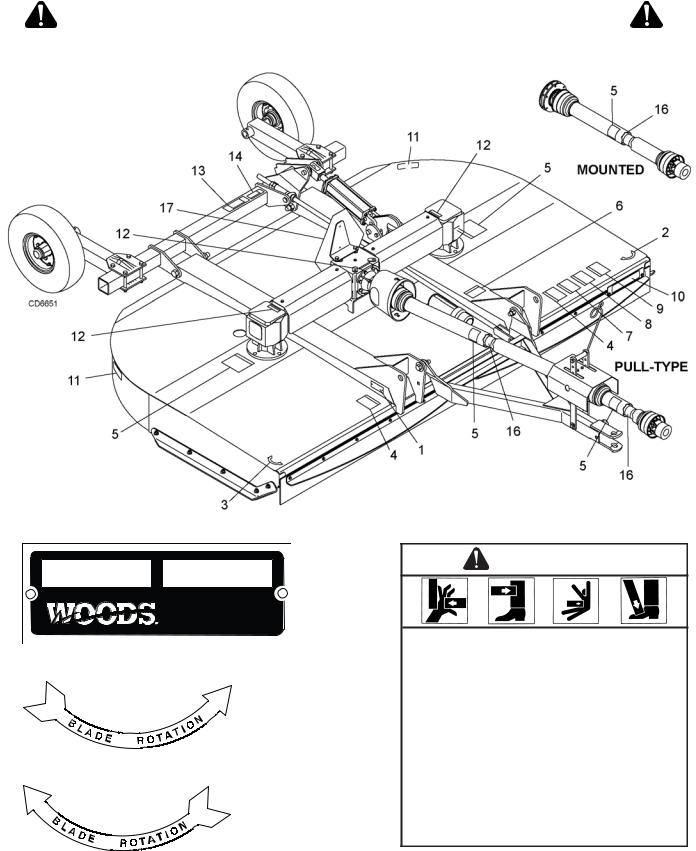
SAFETY & INSTRUCTIONAL DECALS
ATTENTION! BECOME ALERT! YOUR SAFETY IS INVOLVED!
Replace Immediately If Damaged!
1 - SERIAL NUMBER PLATE |
4 - PN 1003751 |
|
WARNING |
MODEL NO. |
SERIAL NO. |
|
Woods Equipment Company |
|
Oregon, Illinois, U.S.A. |
|
CRUSHING AND PINCHING HAZARD |
2 - PN 5669 |
Be extremely careful handling various parts of |
the machine. They are heavy and hands, fingers, |
|
|
feet, and other body parts could be crushed or |
|
pinched between tractor and implement. |
|
Operate tractor controls from tractor seat only. |
|
Do not stand between tractor and implement |
|
when tractor is in gear. |
|
Make sure parking brake is engaged before |
3 - PN 12777 |
going between tractor and implement. |
|
Stand clear of machine while in operation or when it is being raised or lowered.
FAILURE TO FOLLOW THESE
INSTRUCTIONS COULD RESULT IN SERIOUS INJURY OR DEATH. 1003751-A
|
(Safety Decals continued on next page) |
|
|
MAN0390 (Rev. 6/30/2006) |
Safety 11 |
|
|
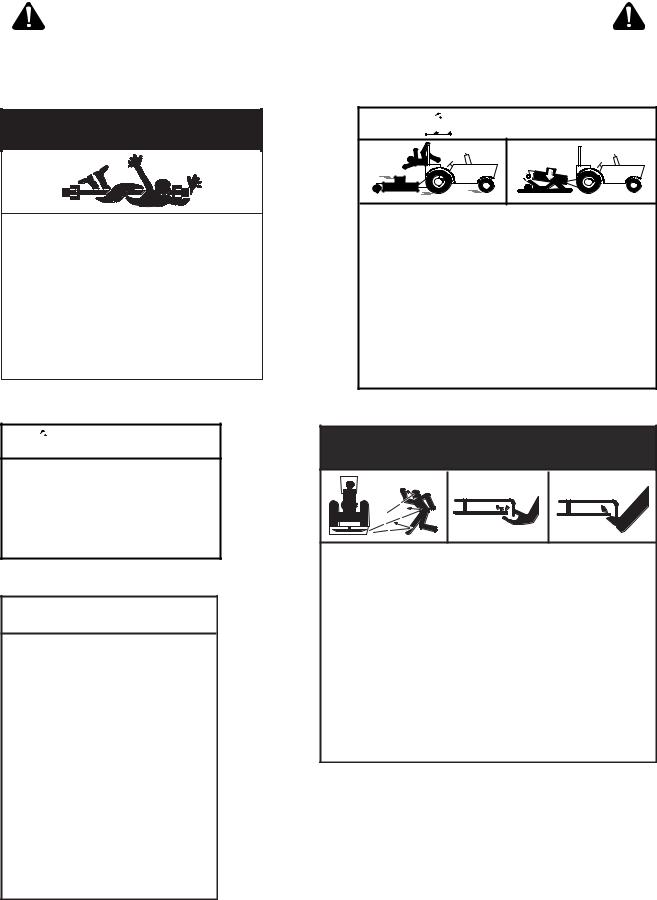
SAFETY & INSTRUCTIONAL DECALS
ATTENTION! BECOME ALERT! YOUR SAFETY IS INVOLVED!
Replace Immediately If Damaged!
(Safety Decals continued from previous page)
5 - PN 18864
 DANGER
DANGER
ROTATING DRIVELINE
CONTACT CAN CAUSE DEATH
KEEP AWAY!
DO NOT OPERATE WITHOUT -
All driveline guards, tractor and equipment shields in place
Drivelines securely attached at both ends
Driveline guards that turn freely on
driveline |
18864-C |
8 - PN 18865


 WARNING
WARNING
FALLING OFF CAN RESULT IN BEING RUN OVER.
Tractor must be equipped with ROPS (or ROPS CAB) and seat belt. Keep foldable ROPS systems in “locked up” position at all times.
Buckle Up! Keep seat belt securely fastened.
Allow no riders.
RAISED EQUIPMENT CAN DROP AND CRUSH.
Before working underneath, follow all instructions and safety rules in operator’s manual and securely block up all corners of equipment with jack stands.
Securely blocking prevents equipment dropping from hydraulic leakdown, hydraulic system failures or mechanical component failures.
FALLING OFF OR FAILING TO BLOCK SECURELY CAN RESULT IN SERIOUS INJURY OR DEATH.
6 - PN 18866



 WARNING
WARNING
540RPM
! " #$
18866-D
7 - PN 18877
 WARNING
WARNING
TO AVOID SERIOUS INJURY OR DEATH:
Read Operator's Manual (available from dealer) and follow all safety precautions.
Keep all shields in place and in good condition.
Operate mower from tractor seat only.
Lower mower, stop engine and remove key before dismounting tractor.
Allow no children or untrained persons to operate equipment.
Do not transport towed or semi-mounted units over 20 mph.
FAILURE TO OPERATE SAFELY
CAN RESULT IN
INJURY OR DEATH.
18877-C
 DANGER
DANGER
ROTATING BLADES AND
THROWN OBJECTS
Do not put hands or feet under or into mower when engine is running.
Before mowing, clear area of objects that may be thrown by blade.
Keep bystanders away.
Keep guards in place and in good condition.
BLADE CONTACT OR THROWN OBJECTS CAN
CAUSE SERIOUS INJURY OR DEATH.
15503-C
10 - PN 1002940 |
12 - PN 1004114 |
||
AMBER REFLECTOR 9" |
|
|
|
|
DANGER |
|
|
11 - PN 57123 |
|
|
|
|
If shaft connection is visible, shield |
||
RED REFLECTOR 9" |
is missing. Replace shield before |
||
|
|
operating equipment. |
1004114 |
|
|
|
|
12 Safety |
MAN0390 (Rev. 6/30/2006) |
|
|
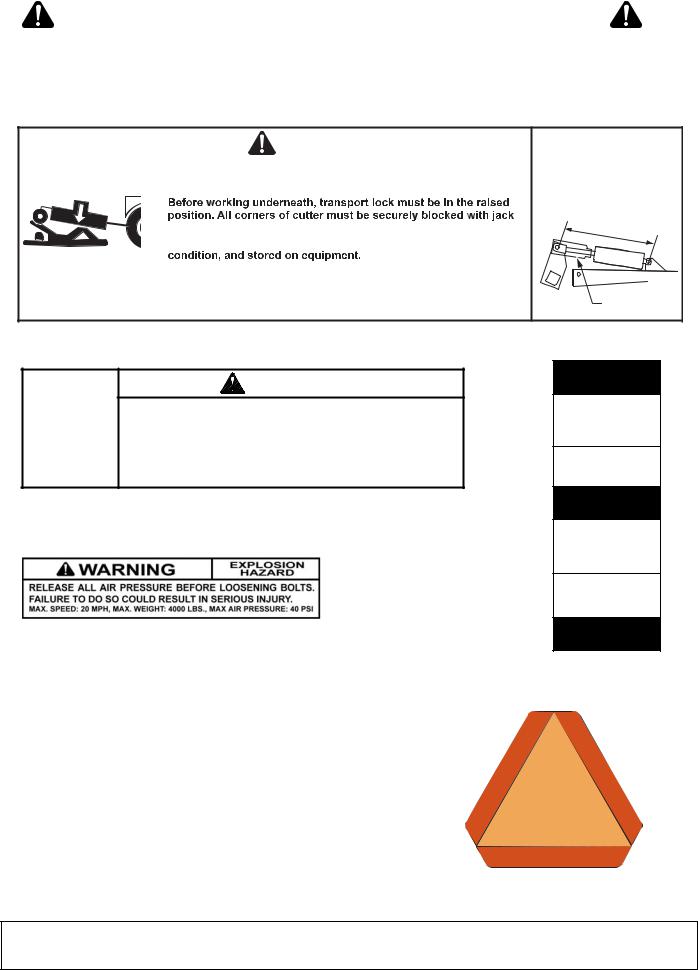
SAFETY & INSTRUCTIONAL DECALS
ATTENTION! BECOME ALERT! YOUR SAFETY IS INVOLVED!
Replace Immediately If Damaged!
13 - PN 1004991
|
|
|
|
|
|
|
|
WARNING |
|
|
|
|
|
|
|
|
RAISED CUTTER CAN DROP AND CRUSH |
|
|
|
|
|
|
|
Cutters must be equipped with transport lock. |
|
|
|
|
|
|
|
|||
|
|
|
|
|
|
|||
|
|
|
|
|
|
|
stands. |
|
|
|
|
|
|
|
|
||
|
|
|
|
|
|
|
||
|
|
|
|
|
|
|
||
|
|
|
|
|
|
All t |
ransport components must be functional, kept in good |
|
|
|
|
|
|
||||
|
|
|
|
|
Blocking up prevents cutter dropping from hydraulic leak down, |
|||
|
|
|
|
|
||||
|
|
|
|
|
||||
|
|
|
|
|
|
|
hydraulic system failures, or mechanical component failures. |
|
|
|
|
|
|
|
|
|
FAILURE TO FOLLOW INSTRUCTIONS CAN |
1004991 |
|
|
|
|
|
RESULT IN SERIOUS INJURY OR DEATH. |
||
|
|
|
|
|
|
|
|
|
TRANSPORT LOCK AND CYLINDER REQUIREMENTS
SINGLE-ACTING FULL
EXTENSION
28-1/4"
TRANSPORT
LOCK
14 - PN 19924
WARNING
Check for leaks with cardboard; never use hand.
Before loosening fittings: lower load, release pressure, and be sure oil is cool.
Consult physician immediately if skin penetration occurs.
PN 1006348
BE CAREFUL!
16 - PN 33347




33347E


Use a clean, damp cloth to clean safety decals.
Avoid spraying too close to decals when using a pressure washer; high-pressure water can enter through very small scratches or under edges of decals causing them to peel or come off.
Replacement safety decals can be ordered free from your Woods dealer. To locate your nearest dealer, check the Dealer Locator at www.WoodsEquipment.com, or in the United States and Canada call 1-800-319-6637.
17 - PN 24611
SLOW MOVING VEHICLE EMBLEM
(Rev. 5/11/2007)
MAN0390 (Rev. 6/30/2006)
Safety 13
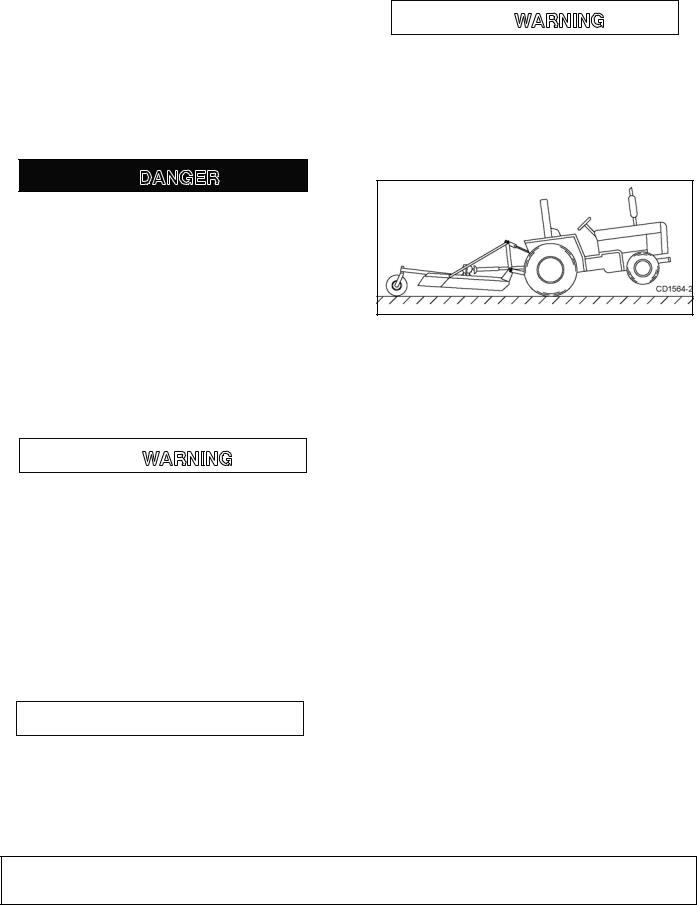
OPERATION
The operator is responsible for the safe operation of the cutter. The operator must be properly trained. Operators should be familiar with the cutter, the tractor, and all safety practices before starting operation. Read the safety rules and safety decals on page 7 to page 13.
This medium-duty cutter is designed for grass and weed mowing and shredding.
Recommended mowing speed for most conditions is from 2 to 5 mph.

Full chain or rubber shielding must be installed when operating in populated areas or other areas where thrown objects could injure people or damage property.
•If this machine is not equipped with full chain or rubber shielding, operation must be stopped when anyone comes within 300 feet (92 m).
•This shielding is designed to reduce the risk of thrown objects. The mower deck and protective devices cannot prevent all objects from escaping the blade enclosure in every mowing condition. It is possible for objects to ricochet and escape, traveling as much as 300 feet (92 m).

Never allow riders on power unit or attachment.
Make sure spring-activated locking pin or collar slides freely and is seated firmly in tractor PTO spline groove.
Operate tractor PTO at 540 RPM. Do not exceed.
Do not allow bystanders in the area when operating, attaching, removing, assembling, or servicing equipment.
Stop power unit and equipment immediately upon striking an obstruction. Turn off engine, remove key, inspect, and repair any damage before resuming operation.
 CAUTION
CAUTION
Always wear relatively tight and belted clothing to avoid getting caught in moving parts. Wear sturdy, rough-soled work shoes and protective equipment for eyes, hair, hands, hearing, and head; and respirator or filter mask where appropriate.
TRACTOR STABILITY

A minimum 20% of tractor and equipment weight must be on the tractor front wheels when attachments are in transport position. Without this weight, front tractor wheels could raise up resulting in loss of steering. The weight may be attained with front wheel weights, ballast in tires or front tractor weights. Weigh the tractor and equipment. Do not estimate.
Figure 1. Tractor Stability
CONNECT CUTTER TO TRACTOR (PULL-TYPE)
NOTICE
■ The horizontal distance between the end of the tractor PTO shaft and the drawbar hitch point should be 14" for 540 RPM cutters. This distance must not vary more than plus or minus (1") or the drive may be damaged when turning.
1.Adjust tractor drawbar to obtain the desired drawbar hitch point distance.
NOTE: On some tractors, a drawbar kit must be used to obtain the required dimension. Check with your tractor dealer for assistance.
2.Install tractor drawbar bracket to the tractor drawbar using cap screw and hex nut.
3.Attach parking jack to cutter tongue. Raise tongue to tractor drawbar height.
4.Place special heat-treated washer between cutter tongue and drawbar.
5.Secure cutter to tractor drawbar with a highstrength drawbar pin 3/4" or larger. Keep pin in place during operation.
6.Attach safety tow chain to drawbar support. Leave enough slack for turning.
14 Operation
(Rev. 2/6/2009) MAN0390 (Rev. 6/30/2006)
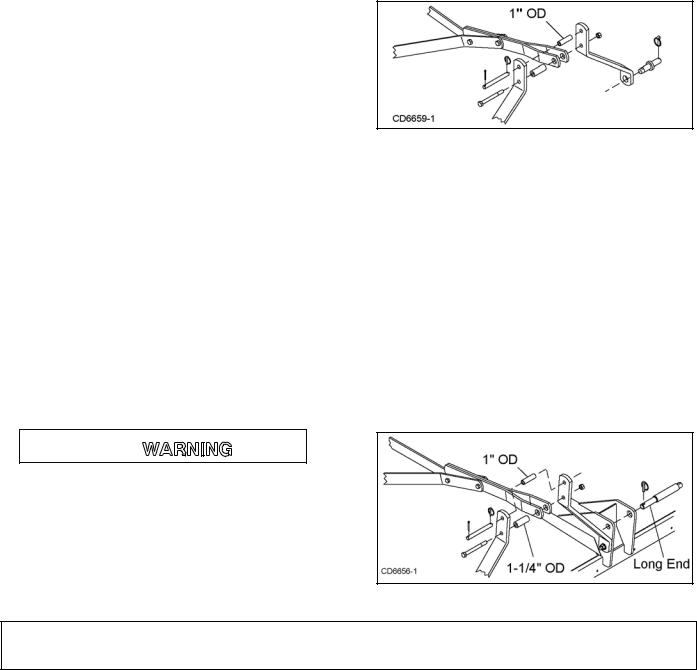
7.Connect cutter driveline to tractor PTO shaft, making sure the spring-activated lock pin slides freely and is seated in tractor PTO splined groove.
8.Remove parking jack from the tongue and attach it to the storage post on the front of the cutter.
9.Adjust H-frame bearing height so that the front driveline is parallel to the ground. Secure with 5/8 x 5-21/32 clevis pin and 3/16 x 1-1/2 cotter pin.
10.Attach drive shaft shield to bearing housing using two 3/8 x 1 cap screws and 3/8 lock washers.
Hydraulic Connection
1.Inspect hydraulic hoses to ensure they are in good condition.
2.Clean the fittings before connecting them to the tractor hydraulic ports.
3.Attach the hydraulic hose to the tractor.
4.Route the hose through the hose holder at the hitch and be sure the hose can slide freely in the holder. Do not allow hose slack to drag on the ground or become caught on tractor protrusions.
5.From the operator position, start tractor and raise and lower deck several times to purge trapped air from the hydraulic cylinder.
Interference Check
1.Be sure that tractor 3-point lift links do not interfere with hydraulic hoses, cutter driveline, or cutter frame.
2.Check for straight-ahead operation and at fullturning angles. If there is any interference, remove the lower lift links.
3.Contact between tractor lift links and cutter parts can cause damage, especially when turning.
CONNECT CUTTER TO TRACTOR (MOUNTED)

A minimum 20% of tractor and equipment weight must be on the tractor front wheels when attachments are in transport position. Without this weight, front tractor wheels could raise up resulting in loss of steering. The weight may be attained with front wheel weights, ballast in tires or front tractor weights. Weigh the tractor and equipment. Do not estimate.
Tractor Adjustments
Before attaching tractor to cutter, install sway blocks or sway chains, or adjust stabilizer bars. Refer to the tractor operator's manual for instructions.
Install tractor front end weights as recommended by the tractor manufacturer to provide 20% of weight on front wheels.
DS96 Category 2 Standard Hitch
1.Position the tractor 3-point lower lift arms over the hitch pins and secure with 7/16 klik pins.
2.Connect the tractor top link to the cutter A-frame using the upper holes and 1" OD sleeve. The break link must be placed in the lower holes of the A- frame. See Figure 2.
Figure 2. DS96 Cat. 2 Standard Hitch Connection
DS96 Category 2 Quick Hitch
An optional Category 2 quick coupler kit (24845) is available for DS96 cutters.
DS120 Category 2 Standard Hitch
1.Position the tractor 3-point lower lift arms between the hitch mast plates and secure with hitch pins and 7/16 klik pins. Note the hitch pins orientation.
2.Connect the tractor top link to the cutter A-frame using the upper holes and 1" OD sleeve. The break link must be placed in the lower holes of the A- frame. See Figure 3.
Figure 3. DS120 Cat. 2 Standard Hitch Connection
(Rev. 2/6/2009)
MAN0390 (Rev. 6/30/2006)
Operation 15
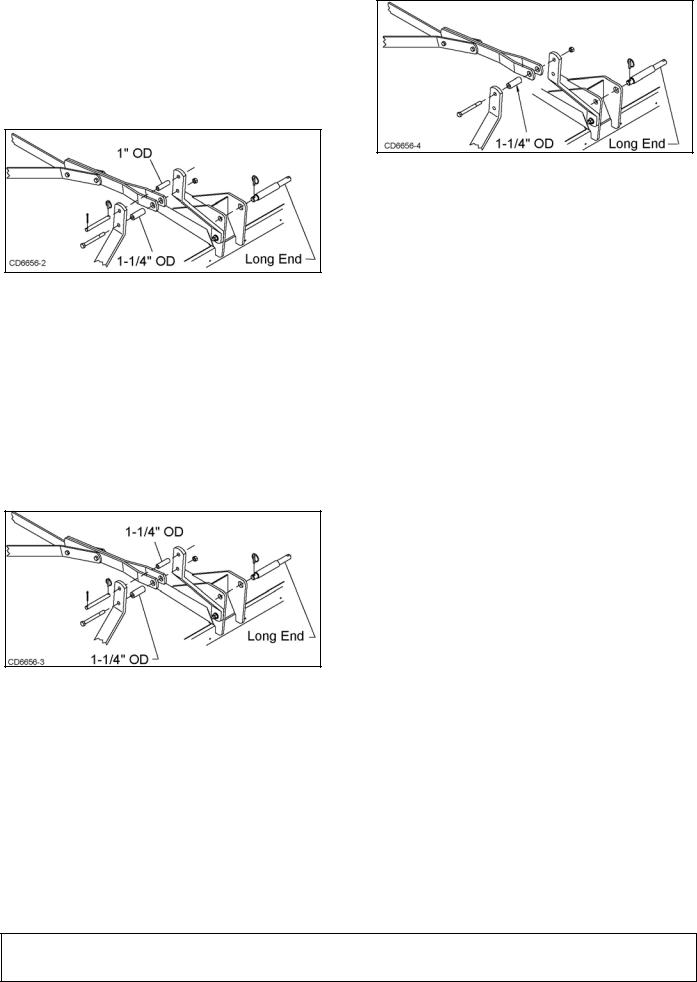
DS120 Category 2 Quick Hitch
1.Position the hitch pins as shown in Figure 4.
2.Attach tractor with quick hitch to cutter and secure according to quick hitch manufacturer’s instructions.
Figure 4. DS120 Category 2 Quick Hitch Connection
DS120 Category 3 Standard Hitch
1.Position the tractor 3-point lower lift arms between the hitch mast plates and secure with hitch pins and 7/16 klik pins. Note the hitch pins orientation.
2.Connect the tractor top link to the cutter A-frame using the upper holes and 1-1/4" OD sleeve. The break link must be placed in the lower holes of the A-frame. See Figure 5.
Figure 5. DS120 Cat. 3 Standard Hitch Connection
DS120 Category 3 Quick Hitch
1.Position the hitch pins as shown in Figure 6.
2.Place break link and 1-1/4" OD sleeve in the top hole of the A-frame and secure.
3.Attach tractor with quick hitch to cutter and secure according to quick hitch manufacturer’s instructions.
Figure 6. DS120 Category 3 Quick Hitch Connection
Hydraulic Connection (DS120 Only)
1.Inspect hydraulic hoses to ensure they are in good condition.
2.Clean the fittings before connecting them to the tractor hydraulic ports.
3.Route hoses through hose holder on 3-point mast. Be sure hoses can slide freely in holder. Do not allow hose slack to drag on the ground or become caught on tractor protrusions.
DRIVELINE ATTACHMENT
Attach the cutter to the tractor 3-point hitch (or quick hitch if available). Do not attach driveline. Raise and lower cutter to determine maximum and minimum distance between the tractor PTO shaft and the gearbox input shaft. If the distance is too large, the driveline will be too short for proper engagement. If distance is too small, the driveline may bottom out in operation and damage the cutter or tractor.
Driveline length must be sufficient to provide at least 1/3 driveline length of engagement during operation. There must be at least 4 inches of engagement at the cutters lowest possible point of operation. The driveline must not bottom out when raised to the maximum height possible.
If driveline is too short please call your Woods dealer for a longer driveline.
If driveline is too long please follow the instructions for shortening the driveline.
SHORTEN DRIVELINE
1.Move cutter up and down to get the shortest possible distance between tractor PTO shaft and gearbox input shaft.
2.Separate driveline into two halves and connect them to the tractor PTO and gearbox.
3.Place driveline halves parallel to one another to determine how much to shorten the driveline.
16 Operation
(Rev. 2/6/2009) MAN0390 (Rev. 6/30/2006)
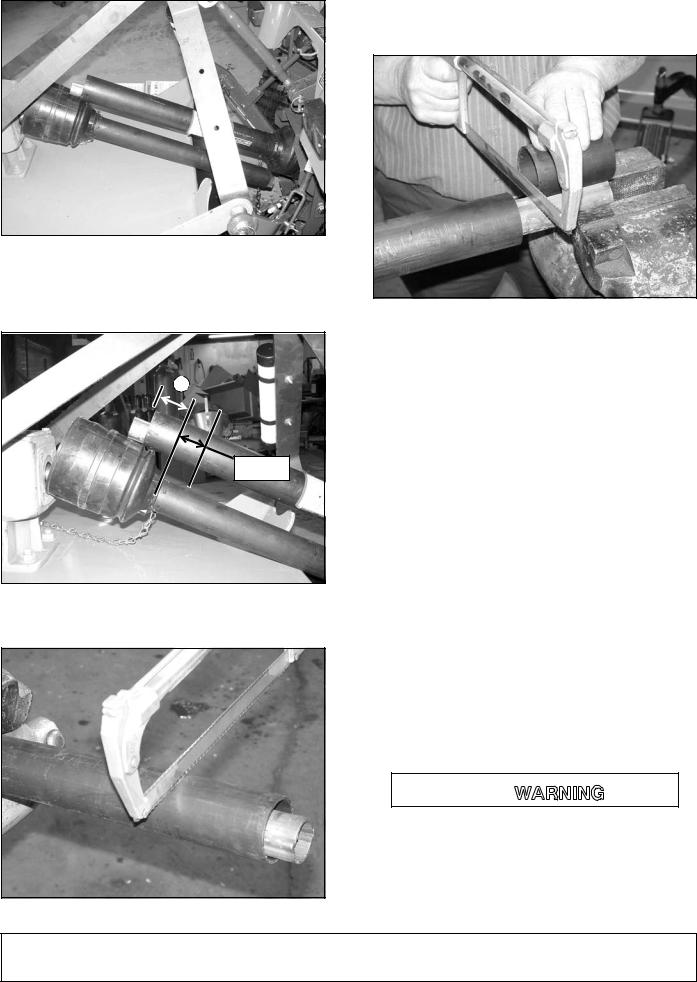
Figure 7. Drive Halves Placed Parallel
4.Measure from end of the upper shield to the base of the bell on the lower shield (A). Add 1-9/16" to dimension (A). See Figure 8.
A
1-9/16"
Figure 8. Determine Shield Length
5. Cut the shield to the overall dimension.
Figure 9. Cut Shield
6.Place the cutoff portion of the shield against the end of the shaft and use as a guide. Mark and cut the shaft.
Figure 10. Cut Shaft to Length
7.Repeat step 6 for the other half of the drive.
8.File and clean cut ends of both drive halves.
Do not use tractor if proper driveline engagement cannot be obtained through these methods.
Connect driveline to tractor PTO shaft, making sure the spring-activated locking collar slides freely and locks driveline to PTO shaft.
NOTICE
■ If attaching with quick hitch the distance between the tractor PTO and gearbox input shaft will increase. Please follow the steps as you would for a 3-point hitch to insure proper engagement.
DRIVELINE INTERFERENCE CHECK
1.Check for clearance between driveline and cutter deck.
2.Slowly lift cutter and observe driveline. If clearance between driveline and cutter deck is less than 1 inch, shorten top link or limit upper travel of lower hitch arms. Refer to tractor operator's manual for instructions.
CUTTING HEIGHT ADJUSTMENT

On pull-type units with optional hydraulic cutting height adjustment, use a single-acting cylinder with a maximum extended length of 28-1/4" (718 mm) from attaching point center to center.
Cutting height range is from 2" to 15". A hydraulic cylinder or ratchet jack is available for cutting height adjust-
(Rev. 2/6/2009)
MAN0390 (Rev. 6/30/2006)
Operation 17
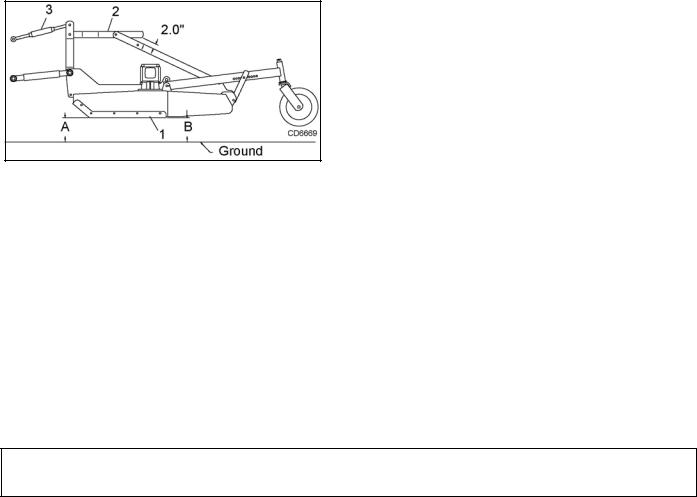
ment on pull-type units and DS120 mounted units. DS96 requires manual adjustment using holes in the tailwheel arms.
When selecting a cutting height, you should consider the area of operation. If the ground is rolling and has mounds the blades could contact, set the cutting height accordingly.
NOTICE
■ Avoid ground contact with blades. Striking ground with blades produces one of the most damaging shock loads a cutter can encounter. If this occurs repeatedly, the cutter, driveline, and gearboxes will be damaged.
The blade cutting edge is approximately 1-3/4 inches above the bottom of the skid shoes.
Pull-Type Units
To adjust cutter for normal mowing, select a cutting height (example: 4-inches).
Using any of the optional cutting height mechanisms, raise or lower the tailwheel and set position A to 2-1/4 inches. Loosen the jam nut on the attitude rod that runs from the tongue to the tailwheel. Adjust rod in or out until position B is approximately 1/4 to 1/2 inches more than position A. Refer to Figure 11.
Figure 11. Cutting Height Adjustment
Mounted Units
To adjust cutter for normal mowing, select a cutting height (example: 4").
Adjust tractor 3-point hitch to obtain a distance of 2-1/4 inches at position A. See Figure 11.
DS96 - Using the various holes in the tailwheel arms, align the tailwheel brace with tailwheel arm to obtain a distance greater than 2-1/4 inches at position B.
Adjust top link to provide 2 inches of clearance between the break link (2) and the rear lift links. See Figure 11. This clearance will allow the cutter to float over uneven terrain.
DS120 - Using any of the optional height adjustment devices, raise or lower the tailwheel to obtain 2-1/2 to 2-3/4 inches at position B.
Adjust top link to provide 2 inches of clearance between the break link (2) and the rear lift links. See Figure 11. This clearance will allow the cutter to float over uneven terrain.
ATTITUDE ADJUSTMENT (PULL-TYPE)
Normal Mowing
For the most economical power use and best cutting results, the cutter should be from 1/2" to 3/4" higher at the rear than at the front.
For grass and weed mowing, adjust cutter to run level or with the front slightly lower.
Shredding
For shredding, it is better to set rear of cutter slightly lower than the front. How much lower depends on the material to be shredded. Determine the best setting for your situation by experimenting. Use a slow ground speed for better shredding.
DRIVELINE ADJUSTMENT (PULL-TYPE)
With the cutting height established, adjust the driveline carrier bearings in the H-frames so that the front driveline is parallel to the ground with cutter in cutting position.
WHEEL SPACING (DS120 ONLY)
Wheels may be adjusted to any position for row crop shredding.
BLADE SELECTION
There are two blade options: standard suction blades and flat double-edge blades.
The standard suction blade is a general use, multi-pur- pose blade.
The double-edge blade requires less power because it does not mulch or recut material. It is designed for use in areas where blade wear is a problem. Sandy soils are extremely hard on blades.
Blade rotation, viewed from top of cutter, is clockwise for the right crossbar, and counter-clockwise for the left crossbar.
When one cutting surface of a double-edge blade is worn, the opposite one may be used by placing the blade on a crossbar of the opposite rotation. Blades from the right may be used on the left. Blades from the left may be used on the right.
18 Operation
(Rev. 2/6/2009) MAN0390 (Rev. 6/30/2006)
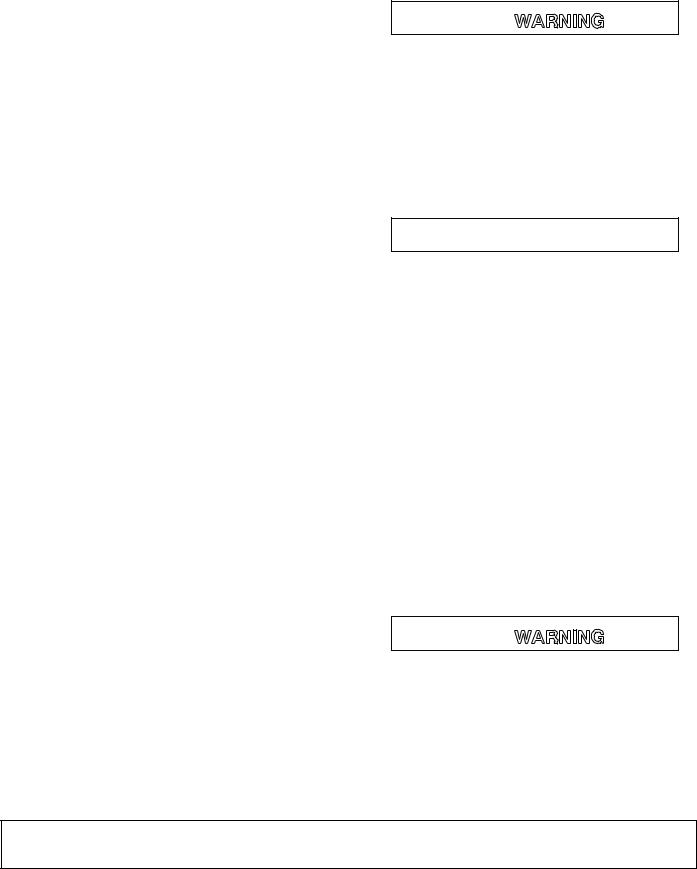
Blades must be moved in pairs. Never use one new blade and one used blade on a crossbar.
TRACTOR OPERATION
Use care when operating around tree limbs and other low objects.
Use care and reduce ground speed on rough terrain. Always watch for hidden hazards.
Being knocked off or falling off tractor can result in serious injury or death.
Only use a tractor with a Roll Over Protective Structure (ROPS) and seat belt. Securely fasten seat belt before starting tractor.
The cutter is operated with tractor controls. Engage the PTO at a low rpm to prevent excessive loads on the cutter drive system. Increase throttle to proper PTO speed (540 rpm).
Be sure operator is familiar with all controls and can stop tractor and cutter quickly in an emergency. The operator should give complete, undivided attention to operating tractor and cutter.
OPERATING TECHNIQUE
Power for operating the cutter is supplied by the tractor PTO. Operate PTO at 540 rpm. Know how to stop the tractor and cutter quickly in an emergency.
Engage PTO at a low engine rpm to minimize stress on the drive system and gearbox. With PTO engaged, raise PTO speed to 540 rpm and maintain throughout cutting operation.
Gearbox protection is provided by a slip clutch with replacement fiber disc. The slip clutch is designed to slip when excessive torsional loads occur.
Move slowly into material. Adjust tractor ground speed to provide a clean cut without lugging the tractor engine. Use a slow ground speed for better shredding.
Proper ground speed will depend on the terrain and the material’s height, type, and density.
Normally, ground speed will range from 2 to 5 mph. Tall, dense material should be cut at a low speed; thin, medium-height material can be cut at a faster ground speed.
Always operate tractor PTO at 540 rpm to maintain blade speed and to produce a clean cut.
Under certain conditions tractor tires may roll down some grass and prevent cutting at the same height as the surrounding area. When this occurs, reduce your ground speed but maintain PTO at 540 rpm. The lower ground speed will permit grass to rebound partially.
Cutter Operation
When beginning operation of the cutter, make sure that all persons are in a safe location. Slowly move into the material with the tractor PTO set at 540 rpm.
Mowing Tips

Look down and to the rear and make sure area is clear before operating in reverse.
Do not operate or transport on steep slopes.
Do not stop, start, or change directions suddenly on slopes.
Use extreme care and reduce ground speed on slopes and rough terrain.
Watch for hidden hazards on the terrain during operation.
 CAUTION
CAUTION
Stop power unit and equipment immediately upon striking an obstruction. Turn off engine, remove key, inspect, and repair any damage before resuming operation.
Maximum recommended ground speed for cutting or shredding is 6 miles per hour. Adjust tractor ground speed by using higher or lower gears to provide a clean cut without lugging tractor engine.
Tall material should be cut twice. Cut material higher the first pass. Cut at desired height at 90 degrees the second pass.
Remember, sharp blades produce cleaner cuts and use less power.
Before entering an area, analyze it to determine the best procedure. Consider the height and type of material to be cut and the terrain type (hilly, level or rough, etc.).
TRANSPORTING

The maximum transport speed for towed and semi-mounted machines is 20 mph (32 km/h). Regardless of the maximum speed capability of the towing tractor, do not exceed the implement’s maximum transport speed. Doing so could result in:
•Loss of control of the implement and tractor
•Reduced or no ability to stop during braking
•Implement tire failure
•Damage to the implement or its components.
(Rev. 2/6/2009)
MAN0390 (Rev. 6/30/2006)
Operation 19
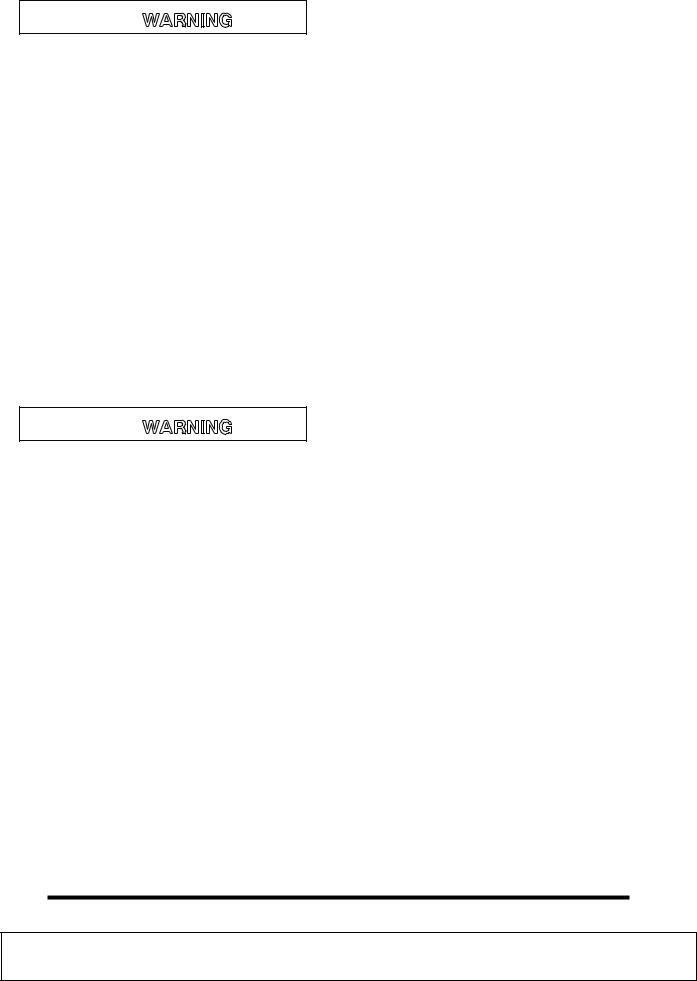

Use additional caution and reduce speed when under adverse surface conditions, turning, or on inclines.
Never tow this implement with a motor vehicle.
1.Always transport with cutter in raised, locked position.
2.Raise cutter with hydraulic cylinder.
3.Rotate transport lock over cylinder rod. See Figure 33 on page 38.
4.Lower cylinder against transport lock.
5.To lower cutter for operation, extend hydraulic cylinder. Rotate transport lock back away from cylinder rod. Lower to desired cutting height.
STORAGE

Keep children and bystanders away from storage area.
On Mounted and Semi-Mounted Cutters:
Disconnect cutter driveshaft and secure up off ground. Raise cutter with 3-point hitch. Place blocks under cutter side skids. Lower cutter onto blocks. Disconnect hydraulic lines to optional cylinder. Disconnect cutter from tractor 3-point hitch and carefully drive tractor away from cutter.
On Pull-Type Cutters:
Raise cutter and block securely. Block wheels and raise tongue with jack. Disconnect hydraulic lines to optional cylinder. Disconnect driveline and secure up off the ground.
PRE-OPERATION CHECK LIST (OWNER'S RESPONSIBILITY)
___ Review and follow all safety rules and safety decal instructions on page 7 to page 13.
___ Check that all safety decals are installed and in good condition. Replace if damaged.
___ Check that equipment is properly and securely attached to tractor.
___ Make sure driveline spring-activated locking pin or collar slides freely and is seated firmly in tractor PTO spline groove.
___ Set tractor PTO at correct rpm for your equipment.
___ Lubricate all grease fitting locations. Make sure PTO shaft slip joint is lubricated.
___ Check that all hydraulic hoses and fittings are in good condition and not leaking before starting tractor. Check that hoses are not twisted, bent sharply, kinked, frayed, or pulled tight. Replace any damaged hoses immediately.
___ Raise and lower equipment to make sure air is purged from hydraulic cylinders and hoses.
___ Check that all hardware is properly installed and secured.
___ Check to ensure blades are sharp, in good condition, and installed correctly. Replace if damaged.
___ Make sure tractor ROPS or ROPS cab and seat belt are in good condition. Keep seat belt securely fastened during operation.
___ Check that shields and guards are properly installed and in good condition. Replace if damaged.
___ Check cutting height, front-to-rear attitude, and top link adjustment.
___ Before starting engine, operator must be in tractor seat with seat belt fastened. Place transmission in neutral or park, engage brake and disengage tractor PTO.
___ Inspect area to be cut and remove stones, branches, or other hard objects that might be thrown and cause injury or damage.
___ Check that chain shielding is in good condition and replace any damaged chain links.
___ Make sure tractor 3-point lift links do not interfere with hydraulic hoses or driveline throughout full turning range.
20 Operation
(Rev. 4/6/2007) MAN0390 (Rev. 6/30/2006)
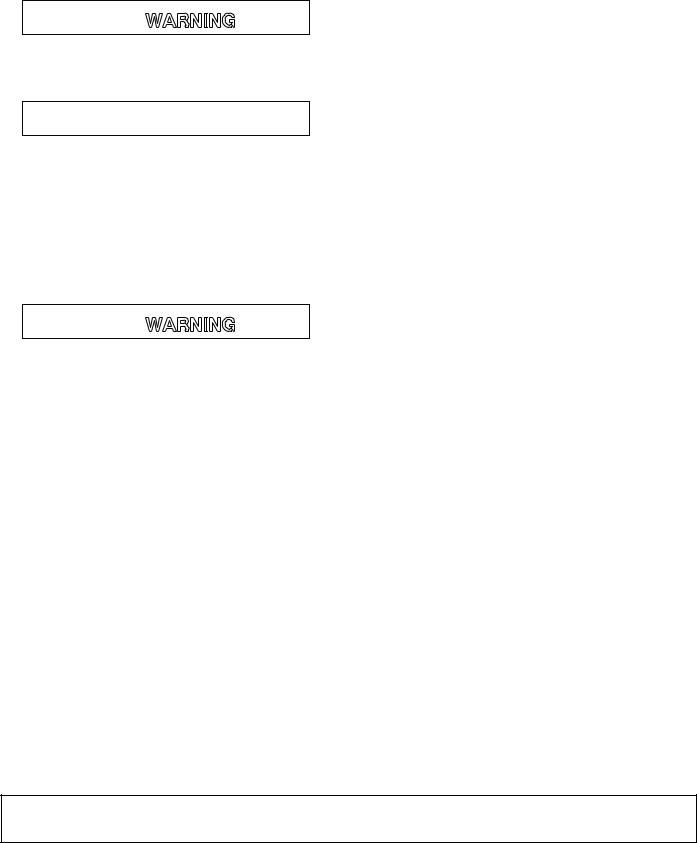
OWNER SERVICE
The information in this section is written for operators who possess basic mechanical skills. If you need help, your dealer has trained service technicians available. For your protection, read and follow the safety information in this manual.

Keep all persons away from operator control area while performing adjustments, service, or maintenance.
 CAUTION
CAUTION
If you do not understand any part of this manual and need assistance, see your dealer.
Always wear relatively tight and belted clothing to avoid entanglement in moving parts. Wear sturdy, rough-soled work shoes and protective equipment for eyes, hair, hands, hearing, and head; and respirator or filter mask where appropriate.
BLOCKING METHOD

Never go underneath equipment (lowered to the ground or raised) unless it is properly blocked and secured. Never place any part of the body underneath equipment or between moveable parts even when the engine has been turned off. Hydraulic system leak down, hydraulic system failures, mechanical failures, or movement of control levers can cause equipment to drop or rotate unexpectedly and cause severe injury or death. Follow Operator's Manual instructions for working underneath and blocking requirements or have work done by a qualified dealer.
To minimize the potential hazards of working underneath the cutter, follow these procedures:
1.Jackstands with a load rating of 1000 lbs. or more are the only approved blocking device for this cutter. Install a minimum of four jackstands (shown by Xs in Figure 12) under the cutter before working underneath unit.
Do not position jackstands under wheels, axles, or wheel supports. Components can rotate and cause cutter to fall.
2.Consider the overall stability of the blocked unit. Just placing jackstands underneath will not ensure your safety.
The working surface must be level and solid to support the weight on the jackstands. Make sure jackstands are stable, both top and bottom. Make sure cutter is approximately level.
3.With full cutter weight lowered onto jackstands, test blocking stability before working underneath.
4.If cutter is attached to tractor when blocking, set the brakes, remove key, and block cutter before working underneath.
5.Securely block rear tractor wheels, in front and behind. Tighten tractor lower 3-point arm anti-sway mechanism to prevent side-to-side movement.
LUBRICATION
Do not let excess grease collect on or around parts, particularly when operating in sandy areas.
See Figure 12 for lubrication points and frequency or lubrication based on normal operating conditions. Severe or unusual conditions may require more frequent lubrication.
Use a lithium grease of #2 consistency with a MOLY (molybdenum disulfide) additive for all locations unless otherwise noted. Be sure to clean fittings thoroughly before attaching grease gun. One good pump of most guns is sufficient when the lubrication schedule is followed.
Gearbox Lubrication
1.Use a high quality gear oil with a viscosity index of 80W or 90W and an API service rating of GL-4 or - 5 in gearboxes.
2.Fill gearbox until oil runs out the the lower hole on back side of center gearbox or side hole on spindle gearboxs. Check gearboxs daily for evidence of leakage, and contact your dealer if leakage occurs.
Driveline Lubrication
1.Lubricate the driveline slip joint every eight operating hours. Failure to maintain proper lubrication could result in damage to U-joints, gearbox, and driveline.
2.Lower cutter to ground, disconnect driveline from tractor PTO shaft, and slide halves apart but do not disconnect from each other.
3.Apply a bead of grease completely around male half where it meets female half. Slide drive halves over each other several times to distribute grease.
4.Grease side drive yoke where yoke attaches to side gearbox.
(Rev. 10/5/2007) MAN0390 (Rev. 4/6/2007)
Owner Service 21
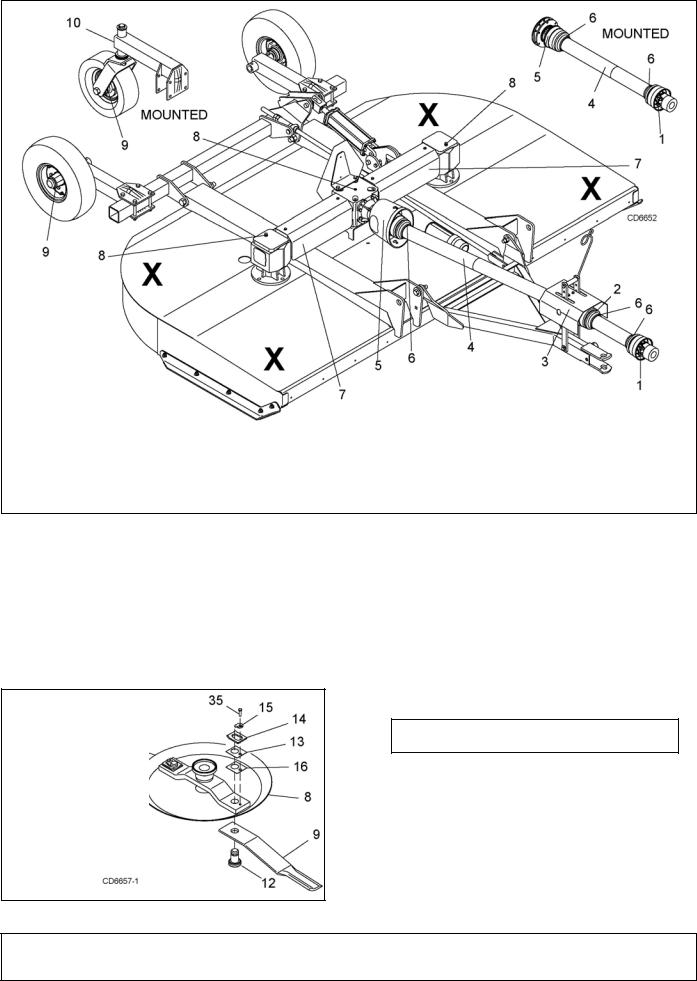
1. |
Front U-Joint |
10 hrs. |
2. |
Mid U-Joint |
10 hrs. |
3. |
Carrier Bearing Block |
40 hrs. |
4. |
Telescoping Shaft |
10 hrs. |
5. |
Rear U-Joint |
10 hrs. |
6. |
Rotating Drive Shield |
10 hrs. |
7. |
Side Drive Yoke (2 Places) |
40 hrs. |
8. |
Gearbox (Check Oil Level, |
|
|
Lower Hole on Center Gearbox |
|
|
Side Hole on Spindle Gearboxs) |
Daily |
9. |
Tailwheel Spindle |
20 hrs. |
10. |
Caster Wheel Swivel |
40 hrs. |
Figure 12. Jackstand Placement and Lubrication Points
SERVICING BLADES
Removing Blades (Figure 13)
NOTICE
■ If blade pin (12) is seized in crossbar and extreme force will be needed to remove it, support crossbar from below to prevent gearbox damage.
1.Disconnect driveline from tractor PTO.
2.Open blade access cover and align crossbar (8) with blade access hole in the cutter frame. Remove cap screw (35), blade pin lock clip (15), keyhole plate (14), and shims (13 & 16). Carefully drive blade pin (12) out of crossbar.
3.Rotate crossbar (8) and repeat for opposite blade.
8.Crossbar
9.Blade
12.Blade pin
13.Shim
14.Keyhole plate
15.Blade pin lock clip
16.Shim
35. Cap screw
Figure 13. Blade Assembly
Installing Blades
 CAUTION
CAUTION
Your dealer can supply genuine replacement blades. Substitute blades may not meet original equipment specifications and may be dangerous.
NOTICE
■ Crossbar rotation has counterclockwise rotation on left gearbox and clockwise rotation on the right gearbox when looking down on cutter. Be sure to install blade cutting edge to lead in correct rotation.
22 Owner Service
(Rev. 10/5/2007) MAN0390 (Rev. 4/6/2007)
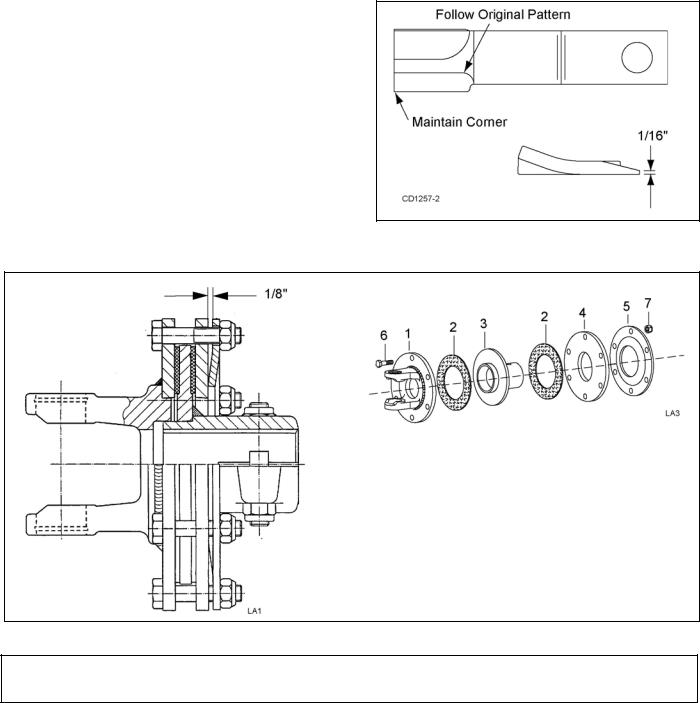
NOTE: Always replace or sharpen both blades at the same time.
1.Inspect blade pin (12) for nicks or gouges, and if you find any, replace the blade pin.
2.Insert blade pin through the blade (9). Blade should swivel on blade pin; if it doesn’t, determine the cause and correct.
3.Align crossbar (8) with blade access hole in cutter frame. Apply a liberal coating of Never Seez or equivalent to blade pin and crossbar hole. Make sure blade offset is away from cutter. Push blade pin through crossbar. Pin should rotate freely prior to installing blade clip (15).
4.Install shims (13 & 16) over blade pin.
NOTE: Only use enough shims to allow keyhole plate (14) to slide into blade pin groove.
5.Install blade clip (15) over keyhole plate and into blade pin groove.
6.Secure into position with cap screw (35). Torque cap screw to 85 lbs-ft.
7.Repeat steps for opposite side.
NOTE: Blade should be snug but should swivel on pin without having to exert excessive force. Keep any spacers not used in the installation as replacements or for future installation.
Sharpening Blades
NOTICE
■ When sharpening blades, grind the same amount on each blade to maintain balance. Replace blades in pairs. Unbalanced blades will cause excessive vibration, which can damage gearbox bearings. Vibration may also cause structural cracks to cutter.
1.Sharpen both blades at the same time to maintain balance. Follow original sharpening pattern.
2.Do not sharpen blade to a razor edge—leave at least a 1/16" blunt edge.
3.Do not sharpen back side of blade.
Figure 14. Sharpen Blade Cutting Edge
1.Flange yoke
2.Friction disc
3.Hub, 1-3/8 round bore
4.Thrust plate
5.Belleville spring plate
6.10 mm x 1.35P x 50 mm Cap screw
7.10 mm x 1.5P Hex nut
Figure 15. Slip Clutch Assembly
(Rev. 5/11/2007) MAN0390 (Rev. 4/6/2007)
Owner Service 23
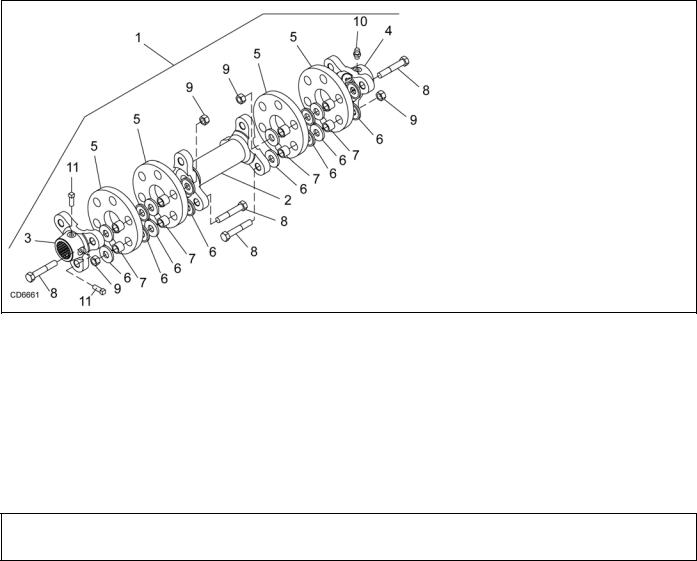
ADJUSTING SLIP CLUTCH
The slip clutch is designed to slip so that the gearbox and driveline are protected if the cutter strikes an obstruction. A new slip clutch or one that has been in storage over the winter may seize. Before operating the cutter, make sure it will slip by performing the following operation:
1.Turn off tractor engine and remove key. Remove driveline from tractor PTO. Loosen six 10 mm cap screws (6) to remove all tension from Belleville spring plate (5).
2.Hold clutch hub (3) solid and turn shaft to make sure clutch slips.
3.If clutch does not slip freely, disassemble and clean the thrust plate faces (4), flange yoke (1), and clutch hub (3).
4.Reassemble clutch. Tighten Belleville spring (5) until it is against the thrust plate (4) of the clutch, and then back off each of the six nuts by two full revolutions. The gap between Belleville spring and thrust plate should be 1/8" as shown in Figure 15.
5.If a clutch continues to slip when the spring is compressed to 1/8", check friction discs (2) for
excessive wear. Discs are 1/8" when new. Replace discs after 1/16" wear. Minimum disc thickness is 1/16".
RUBBER DISK REPLACEMENT
The flexible coupler side drive is designed to flex when striking heavy objects or during start-up to protect gearboxes. The rubber disks will wear out over time and require replacement much like slip clutch disks. To maximize rubber disk life, lower tractor engine speed to an idle when engaging the PTO and avoid striking the ground with cutter blades.
Periodically inspect the disks for signs of cracking. A disk may run for some time after a crack starts but this is the first sign that disk replacement is required in the future.
To replace the disks, remove hardware items (6, 7, 8, and 9). Remove sleeves (7) from old disk and install in new disk. Reassemble and torque bolts to 85 lbs-ft. See Figure 16. Take special care not to rotate gearbox shaft and throw blades out of time. If rubber disks have failed and blades are hitting, you will need to re-time the blades per instructions on page 34.
1.Complete drive
2.Inner connector yoke
3.Outer connector yoke 1-3/4 20-spline
4.Outer connector yoke 1-3/4 6-spline
5.Rubber disc
6.Shaped washer
7.Bushing, .63 ID
8.Hex head cap screw
9.M16 x 2.0 Lock nut
10.Grease fitting
11.3/8 NC x 3/4 Square head set screw
Figure 16. Flexible Coupler
24 Owner Service
(Rev. 2/6/2009) MAN0390 (Rev. 4/6/2007)
